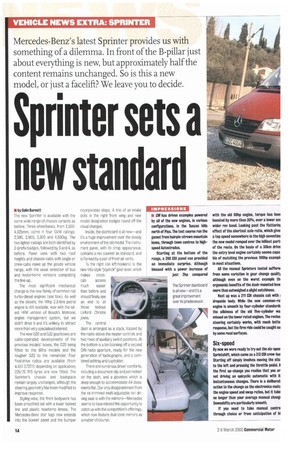Sprinter sets a new standard
Page 16

If you've noticed an error in this article please click here to report it so we can fix it.
Mercedes-Benz's latest Sprinter provides us with something of a dilemma. In front of the B-pillar just about everything is new, but approximately half the content remains unchanged. So is this a new model, or just a facelift? We leave you to decide.
ei by Colin Barnett
The new Sprinter is available with the same wide range of chassis variants as before. Three wheelbases, from 3,5004,025mm, come in four GVW ratings: 2,590, 2,800, 3,500 and 4,600kg. The two lighter ratings are both identified by 2-prefix badges, followed by 3 and 4, as before. Panel vans with two roof heights and chassis-cabs with single or crew-cabs make up the goods vehicle range, with the usual selection of bus and motorhome versions completing the line-up.
The most signIficant mechanical change is the new family of common-rail turbo-diesel engines (see box). As well as the diesels, the 141hp 2.3-litre petrol engine is still available, now with the latest I-1FM version of Bosch's Motronic engine management system, but we didn't drive it and it's unlikely to attract more than very specialised interest.
The new G20 and 032 gearboxes are cable-operated developments of the previous models' boxes, the 020 being fitted to the 80hp models and the tougher G32 to the remainder. Four final-drive ratios are available (from 4.857-3.727:1) depending on application; 225/70 R15 tyres are now fitted. The Sprinter's chassis and loadspace remain largely unchanged, although the steering geometry has been modified to improve response.
Styling-wise, the front bodywork has been smoothed out with a lower bonnet lee and plastic headlamp lenses. The Mercedes-Benz star logo now extends into the bonnet panel and the bumper incorporates steps. A trio of air-intake slots in the right front wing and new model designation badges round off the visual changes.
Inside, the dashboard is all new—and it's a huge improvement over the dowdy environment of the old model. The Instr.; ment panel, with its crisp appearance, contains a rev counter as standard, and is flanked by a pair of fresh air vents.
To the right (on left-hookers) is the new Vito-style loystck" gear lever, which makes cross cab access much easier than before and should finally see an end to all those tedious Linford Christie jokes.
The central dash is arranged as a stack, topped by the radio above the heater controls and two rows of auxiliary switch positions. At the bottom is a bin blanking off a second DIN radio aperture, ready for the new generation of tachographs, and a combined ashtray and cupholder.
There are numerous driver comforts, including a document clip and pen holder on the dash, and a glovebox which is deep enough to accommodate A4 documents flat. Our only disappointment from the re-trimmed multi-adjustable lsri driving seat is with the mirrors—Mercedes seems to have missed the opportunity to catch up with the competition's offerings, which now feature dual-zone mirrors as a matter of course.








































































































